鲁教版(五四学制)九年级全册Unit 1 When was it invented?教学评一体化课时教案(表格式,共7课时)
文档属性
| 名称 | 鲁教版(五四学制)九年级全册Unit 1 When was it invented?教学评一体化课时教案(表格式,共7课时) |
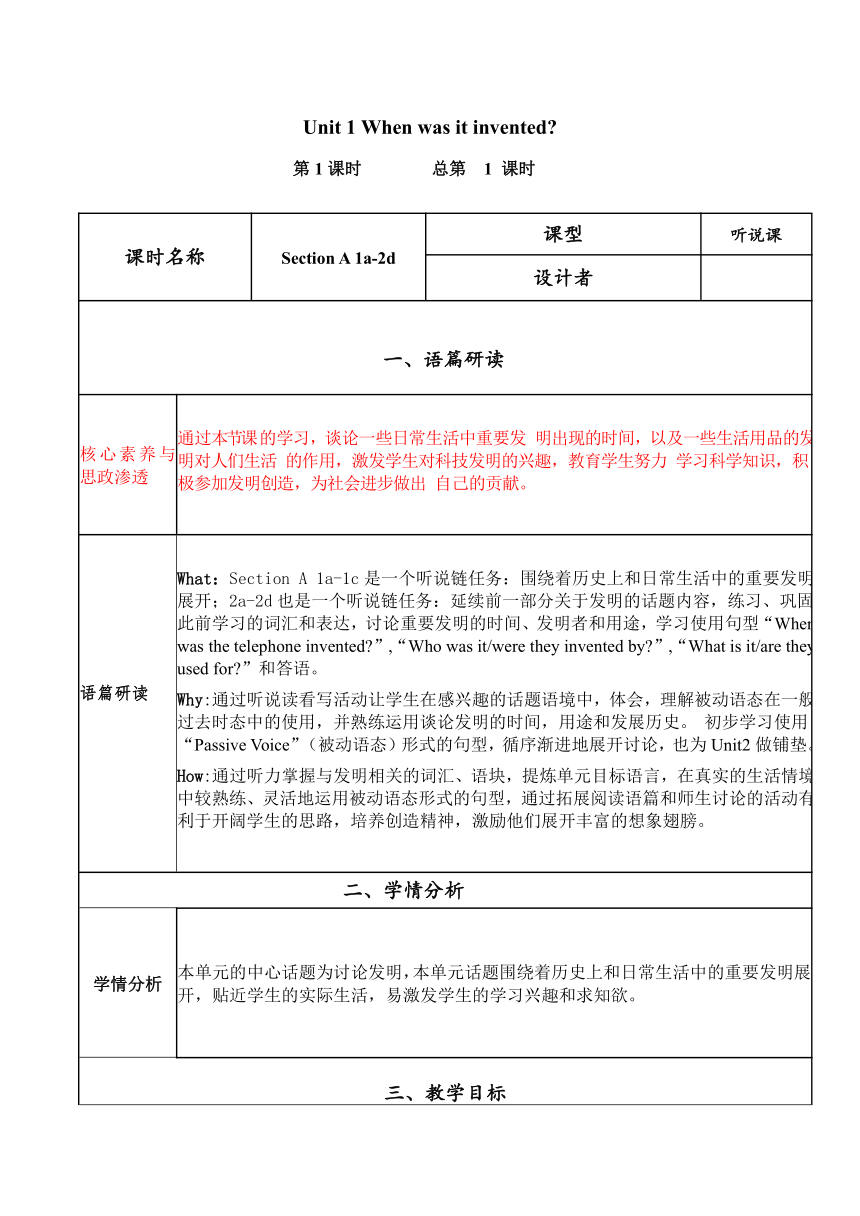
|
|
| 格式 | docx | ||
| 文件大小 | 68.7KB | ||
| 资源类型 | 教案 | ||
| 版本资源 | 鲁教版 | ||
| 科目 | 英语 | ||
| 更新时间 | 2024-10-09 15:12:06 | ||
图片预览

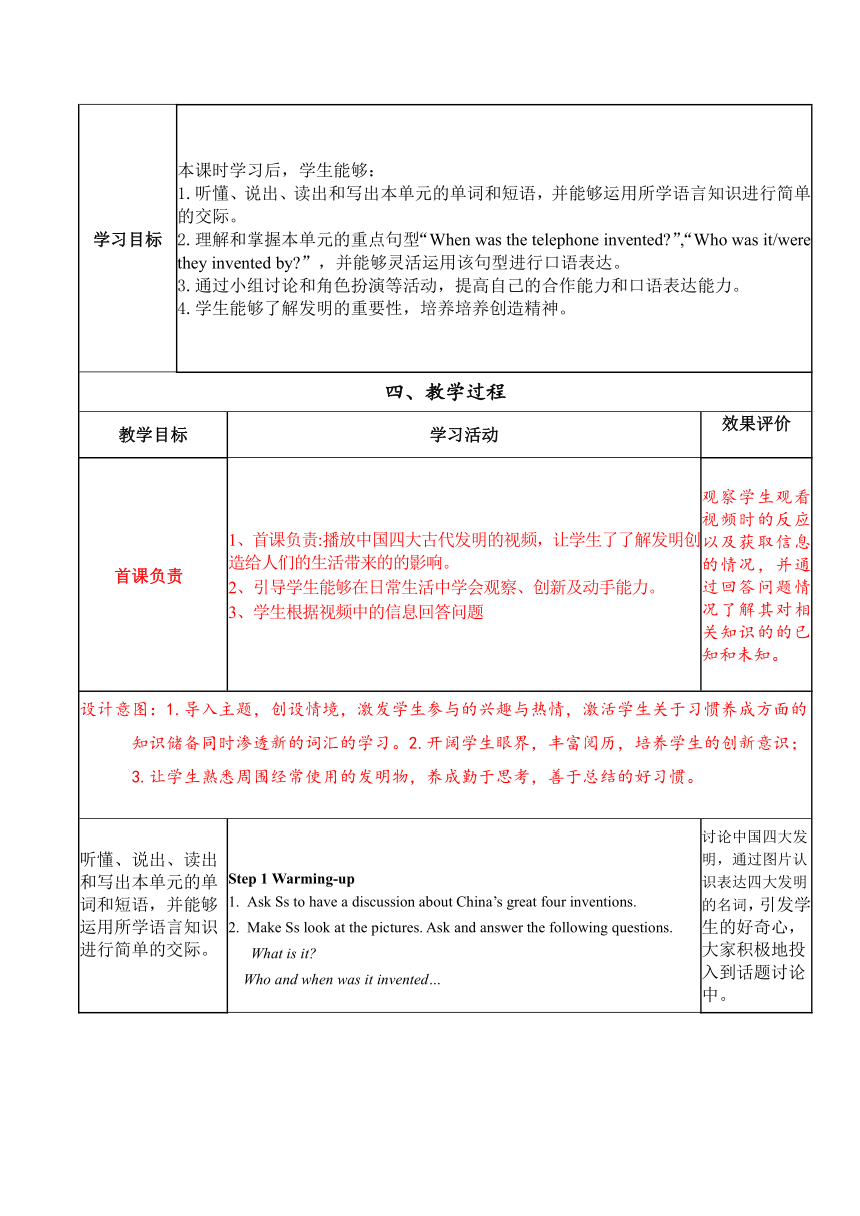
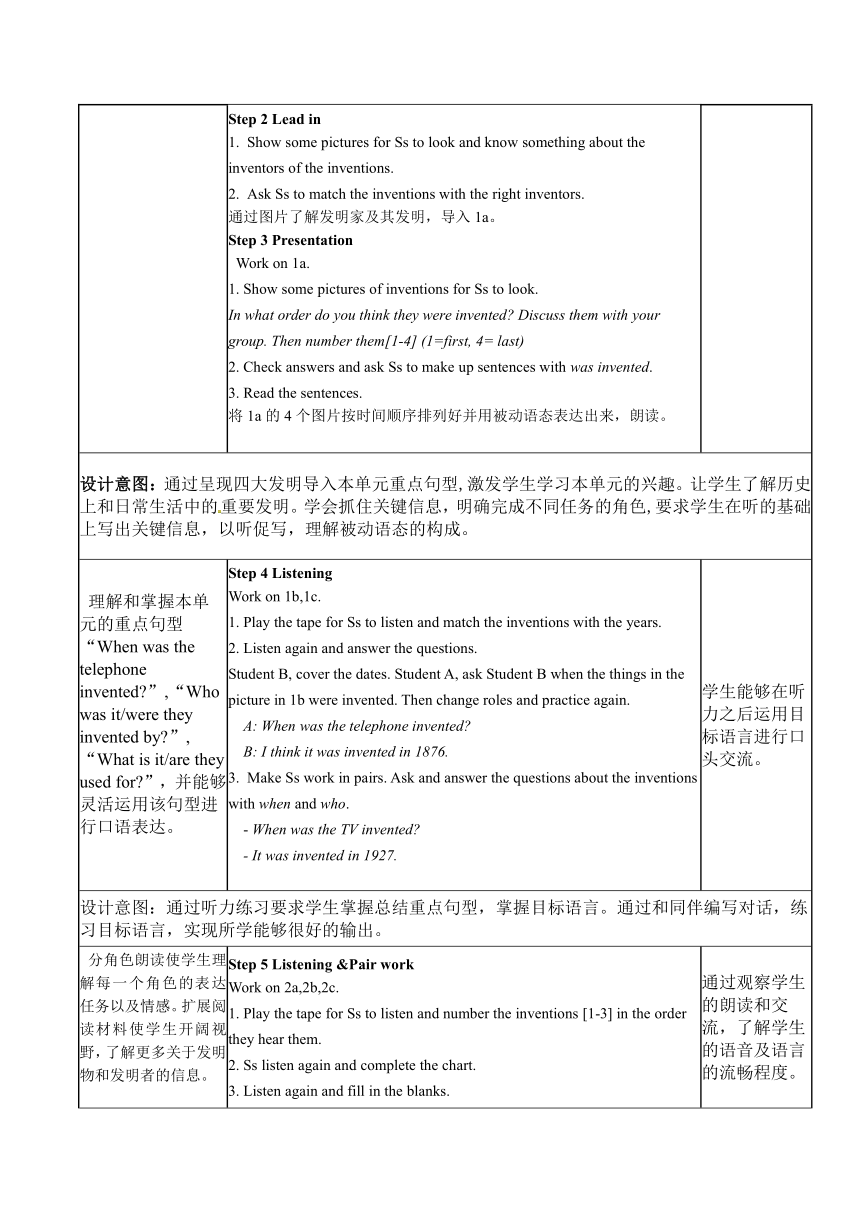
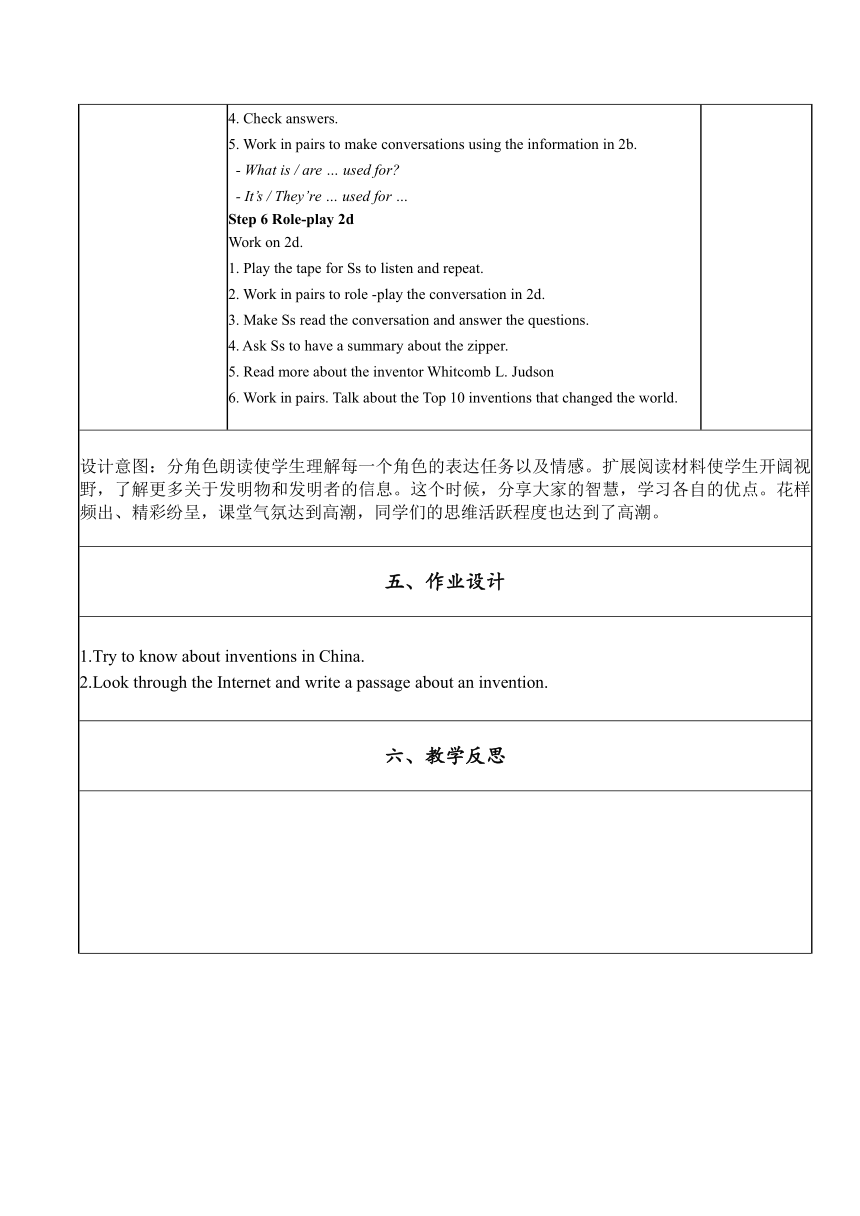
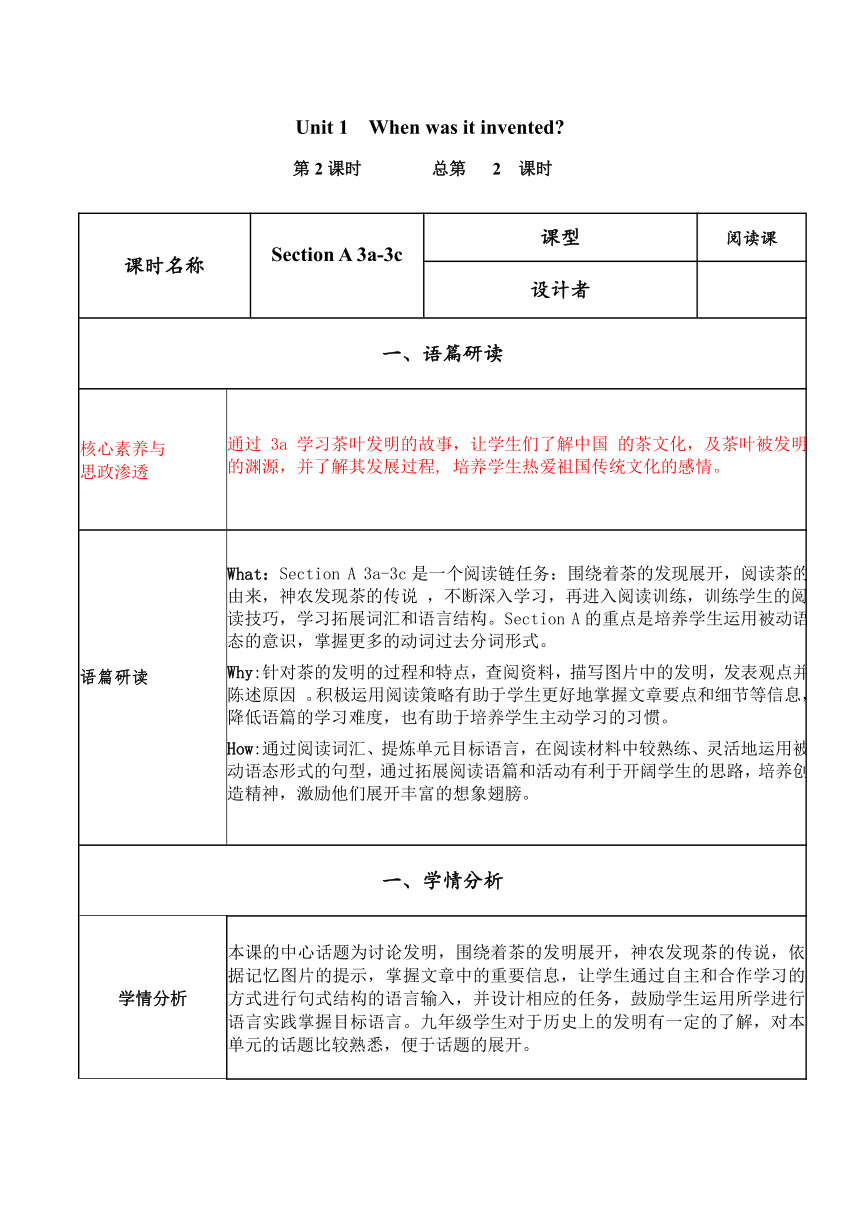
文档简介
Unit 1 When was it invented
第1课时 总第 1 课时
课时名称 Section A 1a-2d 课型 听说课
设计者
一、语篇研读
核心素养与思政渗透 通过本节课 的学习,谈论一些日常生活中重要发 明出现的时间,以及一些生活用品的发明对人们生活 的作用,激发学生对科技发明的兴趣,教育学生努力 学习科学知识,积极参加发明创造,为社会进步做出 自己的贡献。
语篇研读 What:Section A 1a-1c是一个听说链任务:围绕着历史上和日常生活中的重要发明展开;2a-2d也是一个听说链任务:延续前一部分关于发明的话题内容,练习、巩固此前学习的词汇和表达,讨论重要发明的时间、发明者和用途,学习使用句型“When was the telephone invented ”,“Who was it/were they invented by ”,“What is it/are they used for ”和答语。 Why:通过听说读看写活动让学生在感兴趣的话题语境中,体会,理解被动语态在一般过去时态中的使用,并熟练运用谈论发明的时间,用途和发展历史。 初步学习使用“Passive Voice”(被动语态)形式的句型,循序渐进地展开讨论,也为Unit2做铺垫。 How:通过听力掌握与发明相关的词汇、语块,提炼单元目标语言,在真实的生活情境中较熟练、灵活地运用被动语态形式的句型,通过拓展阅读语篇和师生讨论的活动有利于开阔学生的思路,培养创造精神,激励他们展开丰富的想象翅膀。
二、学情分析
学情分析 本单元的中心话题为讨论发明,本单元话题围绕着历史上和日常生活中的重要发明展开,贴近学生的实际生活,易激发学生的学习兴趣和求知欲。
三、教学目标
学习目标 本课时学习后,学生能够: 1.听懂、说出、读出和写出本单元的单词和短语,并能够运用所学语言知识进行简单的交际。 2.理解和掌握本单元的重点句型“When was the telephone invented ”,“Who was it/were they invented by ”,并能够灵活运用该句型进行口语表达。 3.通过小组讨论和角色扮演等活动,提高自己的合作能力和口语表达能力。 4.学生能够了解发明的重要性,培养培养创造精神。
四、教学过程
教学目标 学习活动 效果评价
首课负责 1、首课负责:播放中国四大古代发明的视频,让学生了了解发明创造给人们的生活带来的的影响。 2、引导学生能够在日常生活中学会观察、创新及动手能力。 3、学生根据视频中的信息回答问题 观察学生观看视频时的反应以及获取信息的情况,并通过回答问题情况了解其对相关知识的的已知和未知。
设计意图:1.导入主题,创设情境,激发学生参与的兴趣与热情,激活学生关于习惯养成方面的知识储备同时渗透新的词汇的学习。2.开阔学生眼界,丰富阅历,培养学生的创新意识;3.让学生熟悉周围经常使用的发明物,养成勤于思考,善于总结的好习惯。
听懂、说出、读出和写出本单元的单词和短语,并能够运用所学语言知识进行简单的交际。 Step 1 Warming-up Ask Ss to have a discussion about China’s great four inventions. Make Ss look at the pictures. Ask and answer the following questions. What is it Who and when was it invented… 讨论中国四大发明,通过图片认识表达四大发明的名词,引发学生的好奇心,大家积极地投入到话题讨论中。
Step 2 Lead in Show some pictures for Ss to look and know something about the inventors of the inventions. Ask Ss to match the inventions with the right inventors. 通过图片了解发明家及其发明,导入1a。 Step 3 Presentation Work on 1a. 1. Show some pictures of inventions for Ss to look. In what order do you think they were invented Discuss them with your group. Then number them[1-4] (1=first, 4= last) 2. Check answers and ask Ss to make up sentences with was invented. 3. Read the sentences. 将1a的4个图片按时间顺序排列好并用被动语态表达出来,朗读。
设计意图:通过呈现四大发明导入本单元重点句型,激发学生学习本单元的兴趣。让学生了解历史上和日常生活中的重要发明。学会抓住关键信息,明确完成不同任务的角色,要求学生在听的基础上写出关键信息,以听促写,理解被动语态的构成。
理解和掌握本单元的重点句型 “When was the telephone invented ”,“Who was it/were they invented by ”,“What is it/are they used for ”,并能够灵活运用该句型进行口语表达。 Step 4 Listening Work on 1b,1c. 1. Play the tape for Ss to listen and match the inventions with the years. 2. Listen again and answer the questions. Student B, cover the dates. Student A, ask Student B when the things in the picture in 1b were invented. Then change roles and practice again. A: When was the telephone invented B: I think it was invented in 1876. Make Ss work in pairs. Ask and answer the questions about the inventions with when and who. - When was the TV invented - It was invented in 1927. 学生能够在听力之后运用目标语言进行口头交流。
设计意图:通过听力练习要求学生掌握总结重点句型,掌握目标语言。通过和同伴编写对话,练习目标语言,实现所学能够很好的输出。
分角色朗读使学生理解每一个角色的表达任务以及情感。扩展阅读材料使学生开阔视野,了解更多关于发明物和发明者的信息。 Step 5 Listening &Pair work Work on 2a,2b,2c. 1. Play the tape for Ss to listen and number the inventions [1-3] in the order they hear them. 2. Ss listen again and complete the chart. 3. Listen again and fill in the blanks. 4. Check answers. 5. Work in pairs to make conversations using the information in 2b. - What is / are … used for - It’s / They’re … used for … Step 6 Role-play 2d Work on 2d. 1. Play the tape for Ss to listen and repeat. 2. Work in pairs to role -play the conversation in 2d. 3. Make Ss read the conversation and answer the questions. 4. Ask Ss to have a summary about the zipper. 5. Read more about the inventor Whitcomb L. Judson 6. Work in pairs. Talk about the Top 10 inventions that changed the world. 通过观察学生的朗读和交流,了解学生的语音及语言的流畅程度。
设计意图:分角色朗读使学生理解每一个角色的表达任务以及情感。扩展阅读材料使学生开阔视野,了解更多关于发明物和发明者的信息。这个时候,分享大家的智慧,学习各自的优点。花样频出、精彩纷呈,课堂气氛达到高潮,同学们的思维活跃程度也达到了高潮。
作业设计
1.Try to know about inventions in China. 2.Look through the Internet and write a passage about an invention.
教学反思
Unit 1 When was it invented
第2课时 总第 2 课时
课时名称 Section A 3a-3c 课型 阅读课
设计者
一、语篇研读
核心素养与 思政渗透 通过 3a 学习茶叶发明的故事,让学生们了解中国 的茶文化,及茶叶被发明的渊源,并了解其发展过程, 培养学生热爱祖国传统文化的感情。
语篇研读 What:Section A 3a-3c是一个阅读链任务:围绕着茶的发现展开,阅读茶的由来,神农发现茶的传说 ,不断深入学习,再进入阅读训练,训练学生的阅读技巧,学习拓展词汇和语言结构。Section A的重点是培养学生运用被动语态的意识,掌握更多的动词过去分词形式。 Why:针对茶的发明的过程和特点,查阅资料,描写图片中的发明,发表观点并陈述原因 。积极运用阅读策略有助于学生更好地掌握文章要点和细节等信息,降低语篇的学习难度,也有助于培养学生主动学习的习惯。 How:通过阅读词汇、提炼单元目标语言,在阅读材料中较熟练、灵活地运用被动语态形式的句型,通过拓展阅读语篇和活动有利于开阔学生的思路,培养创造精神,激励他们展开丰富的想象翅膀。
学情分析
学情分析 本课的中心话题为讨论发明,围绕着茶的发明展开,神农发现茶的传说,依据记忆图片的提示,掌握文章中的重要信息,让学生通过自主和合作学习的方式进行句式结构的语言输入,并设计相应的任务,鼓励学生运用所学进行语言实践掌握目标语言。九年级学生对于历史上的发明有一定的了解,对本单元的话题比较熟悉,便于话题的展开。
三、教学目标
学习目标 本课时学习后,学生能够: 1.能进一步谈论常见发明物的历史,如: 2.能进一步用被动语态谈论发明物的使用情况 3.能读懂关于“茶历史”的文章。 4.能简单描述“茶历史”。
四、教学过程
教学目标 学习活动 效果评价
首课负责 Watch a video and know about the tea culture. 观察学生讨论及展示情况,并通过回答问题情况了解其对相关知识的的已知和未知。
设计意图:①了解中国茶文化的起源和发展,培养传播茶文化的意识; ②通过对茶文化进一步的了解,增强文化自信,体会中华文化的博大精深与源远流长,形成中华文化认同感。
对本课的任务型阅读活动进行有效的交流与表述,并能够运用所学语言知识进行简单的交际。 Step 1 Lead in Show a video about Tea to let Ss learn about the Chinese tea. Q1. What is the video about --It’s about the tea. Q2. Who is the writer of Cha Jing --Lu Yu. 播放视频《陆羽和茶》,让学生了解中国的茶文化及茶叶被发明的渊源,并了解其发展过程。 先阅读所给的三句话,然后快速阅读短文,抓住每一段的主题句,找到答案。
Step 2.Reading Pre-reading Predicting :Try to guess the topic from the title and picture before you read. 二、While-reading Fast reading Task1:Read the title and the first sentence. T: How was tea invented Ss:It was invented by accident. Task2:Skimming&match (
Lu Yu and his book Cha Jing
How tea spread to other countries
How tea was invented by accident
)Para. 1 Para. 2 Para. 3 Ss read the article quickly and match each paragraph with its main idea. Careful reading: Read the paragraph,then complete the mind-map Make a short report like this: Who: What: Where (country):How: Shen Nong was drinking water when some leaves the water and there for some time.It a pleasant smell.Shen Nong the brown water and it tasted delicious.Result:One of the world’s favorite was invented.
设计意图:对本课的任务型阅读活动进行有效的交流与表述;读前,读中,读后设计活动,帮助学生在宏观,微观角度把握语篇。
理解和掌握本单元的重点句型,并能够灵活运用该句型进行口语表达。 Step 4 Task 3(Read the third paragraph,and complete the sentences) Tea was brought to Korea and Japan during In England,tea didn’t appear until around The tea trad from China to Western countries took place in the Post-reading:Retell the story of tea 学生能够在阅读之后运用目标语言进行复述交流。
设计意图:通过阅读练习要求学生掌握总结重点句型,掌握目标语言。通过复述课文,练习目标语言,实现所学能够很好的输出。
复述使学生理解阅读材料的表达任务以及情感。扩展阅读材料使学生开阔视野,了解更多关于发明物和发明者的信息。 Step 5 Work on 3b,3c. Task 1:Draw your mind-map according to the passage. Task 2:Retell one paragraph according to your mind-map. (T:We should use our imagination to develop our creative spirit of science) Task 3:Work on 3c 通过观察学生的朗读和交流,了解学生的语音及语言的流畅程度。
设计意图:扩展阅读材料使学生开阔视野,了解更多关于发明物和发明者的信息。这个时候,分享大家的智慧,学习各自的优点。花样频出、精彩纷呈,课堂气氛达到高潮,同学们的思维活跃程度也达到了高潮。
五、作业设计
Draw a mind-map then try to recite the passage . Preview 1a-1e on page 5.
六、教学反思
Unit 1 When was it invented
第3课时 总第 3 课时
课时名称 Section A 4a-4c 课型 语法课
设计者
一、语篇研读
语篇研读 What:学生对于常用动词的过去分词和一般过去时态主动被动的判断与转换,通过学习,了解一些重要发明的历史,教学一般过去时的被动语态。通过听说读看写活动让学生在感兴趣的话题语境中,体会,理解被动语态在一般过去时态中的使用,并熟练运用谈论发明的时间,用途和发展历史。 。 Why:让学生在语境中感知一般过去时态的被动语态的使用,学生能理解和掌握运用发明和发明史相关的生词与短语,理解和掌握运用一般过去时态被动语态结构。 How:让学生在语境中感知一般过去时态的被动语态的使用。通过对比分析,掌握一般现在时和一般过去时态被动语态,用思维导图的方式进行阅读,提高阅读理解的有效性。
二、学情分析
学情分析 学生对被动语态也有一定的了解,体会被动语态的结构和表意功能。这为学习本单元内容打下了良好的基础,在听说训练过程中,让学生通过自主和合作学习的方式进行句式结构的语言输入,并设计相应的任务.
三、教学目标
学习目标 本课时学习后,学生能够: 能正确辨析文章中句子的语态, 正确使用动词的被动形式, 能将主动语态变被动语态,
四、教学过程
教学目标 学习活动 效果评价
认识并熟记短语并掌握重点句型When was it invented?It was invented in…,Who was it invented by?It was invented by…,What was/is it used for?It was/is used for… Step1:Find the sentences with passive voice in the simple past tense. 归纳:一般过去时态被动语态构成:was/were+及物动词的过去分词 一般过去时的被动语态的句型肯定句 否定句 一般疑问句 特殊疑问句
利用已知和文本初度梳理语法知识,总结规律。
Step2:Grammar Stage Task1:Let students look at grammar focus. Ask : “what do these sentence have in common .” Task 2:Make a comparison about present tense and past tense. Let students think about how to turn the present tense into a past tense Show the sentences and analysis the structure of them Task 3:Show the chart about past tense of passive voice. Make a conclusion. Show some exercises and let students finish them. Task 4:Show the special situation about passive voice; let students pay attention to them.
设计意图:通过简单的梳理上节课的重要知识点,帮助学生复习巩固所学内容,同时为本节课打好基础。引导学生去观察总结,让学生自己发现规律,培养学生的自主学习能力,要求学生在听的基础上写出关键信息,以听促写,理解被动语态的构成。
正确运用本单元语法知识点来表达思想,锻炼思维能力。 Step 3:Practice Let students finish the exercises and check the answer Make Ss work in pairs. Ask and answer the questions about the inventions with when and who. - When was the TV invented - It was invented in 1927. 学生能够在语法学习之后,以做报告的形式进行口头输出。
设计意图:让学生先自己解决一些问题,然后再讲解不会的。培养学生的语言运用能力,检测本节课所学语法知识点。
Step 5 Work on 2d. Read more about the inventor Whitcomb L. Judson Work in pairs. Talk about the Top 10 inventions that changed the world. 学习根据评价表,组内评分,教师通过评分进行跟踪和总结。
设计意图:总结本堂课的目标语言,深层次加工所学语言,加深印象。
五、作业设计
Draw a mind-map then try to recite the passage . Preview 1a-1e on page 5.
六、教学反思
Unit 1 When was was it invented
第4课时 总第 4 课时
课时名称 SectionB1a-1e 课型 听说课
设计者
语篇研读
核心素养与思政渗透 1.1c,1d 主要介绍了现代生活中一项美食发明—— 薯片。让学生了解世界上一些对人类有着重大意义的发明的相关信息,开阔学生的眼界,养成勤于思考, 善于发现的好习惯,培养学生的创造精神。
语篇研读 【what】这一部分是对本单元主题的发展和纵深讨论,侧重有关食物味道的新单词,引出讨论薯条的发明历史,复习前面的语言 。 【why】围绕发明创造这个话题,要求学生继续学习巩固相关的内容和语言知识。在语言技能上,对听说读写的专项训练和综合训练在本部分里都有体现。在语言策略上,提出让学生学习使用思维导图,以加深对文章的理解和对知识的记忆。 【How】在听力训练过程中,需要学生运用信息综合判断等,训练捕捉信息、处理信息的能力。在阅读训练中,需要学生学习和掌握如何利用思维导图帮助理清、记忆阅读语篇中的相关信息,把获取的信息转换成图形来帮助记忆。积极运用阅读策略有助于学生更好地掌握文章要点和细节等信息,降低语篇的学习难度,也有助于培养学生主动学习的习惯。
二、学情分析
学情分析 学生在八下对被动语态的一般现在时形式已经有了初步的认识,对被动语态也有一定的了解,体会被动语态的结构和表意功能。这为学习本单元内容打下了良好的基础,在听说训练过程中,让学生通过自主和合作学习的方式进行句式结构的语言输入,并设计相应的任务,鼓励学生运用所学进行语言实践掌握目标语言。
三、教学目标
学习目标 本课时学习后,学生能够: 1.能够运用形容词描述物品的味道,如:sweet, crispy, salty, sour等。 2.能够听懂薯片的发明历史并获取关键信息,完成听力任务。 3.能模仿目标语的结构和语调进行初步表达简述薯片的发明史。
四、教学过程
教学目标 学习活动 效果评价
首课负责 首课负责:播放人们享受各种美食的视频:薯片,酸奶,汉堡,火腿,米线,螺蛳粉,让学生观察生活中的美食 思考这些美食是怎么发明创造的并怎样影响人们生活的。 3.小组讨论;你还能想到哪些美食中的发明创造 观察学生观看视频时的反应以及获取信息的情况,并通过回答问题情况了解其对相关知识的的已知和未知。
设计意图:1.导入主题,创设情境,激发学生参与的兴趣与热情,激活学生关于习惯养成方面的知识储备同时渗透新的词汇的学习。2.开阔学生眼界,丰富阅历,培养学生的创新意识;3.让学生熟悉周围经常使用的发明物,养成勤于思考,善于总结的好习惯。
通过听力训练来复习形容词描述物品的味道,如:sweet, crispy, salty, sour等。 Step 1 Warming-up Look at some delicious food. Ask students how they think of them. Step 2 Talking 1a&1b Work on 1a Tell Ss that the words in the box describe how food can taste. Write them under the correct pictures. Some pictures have more than one word. Ss work with their partners and try to write some proper words under the pictures. Let some Ss read their answers. Try to remember the new words. Work on 1b 1.Let some Ss read the adj. In the box. Make sure they all know the meaning of each word. 2.Ss discuss with their partners. Try to write the names of different kinds of food after each adj. 3.Read the new words together. 介绍薯片的发明历史并引导获取关键信息,完成听力任务。
Step 3 Listening 1c&1d Work on 1c T: Show a picture and ask Ss: Do you like potato chips How do they taste Do you know when and how it was invented Let Ss read the sentences in 1c. Make sure they all know the meaning of each sentence. Play the recording for the Ss. Listen and judge the sentences T or F. Check the answers together. Work on 1d Let Ss read the article in 1d first. Tell Ss to listen for two times and fill in the blanks with the right words.
设计意图:让学生观看图片,在情境中学习表达,同时培养学生学以致用的能力,并为后续听力环节做铺垫。
能模仿目标语的结构和语调进行初步表达简述薯片的发明史。 (
The History of Potato Chips
Do you know how potato chips were invented Potato chips __________by a cook called George Grum. They were invented in _______. George Crum cut the potatoes really, really ______ and then cooked them for a long time until they were _______. Finally he put lots of salt on them so they were __________.
) Step 4 Pair work 1e 1. Work in pairs. Make a conversation about the invention of potato chips. Use the information in 1c and 1d. 2. Ask some pairs to act out their conversation in front of the class. A:Did you know potato chips were invented by mistake B: Wow, I didn’t know that. Who invented them A:... Step5 Summary Ask students to summarize what they have learned in this part. 学生能够在多次阅读之后,口头简要介绍薯片的发明史。 总结本堂课的目标语言,深层次加工所学语言,加深印象。
设计意图:通过介绍薯片的发明史,让学生充分运用语料,提供学生操练目标知识的机会,帮助学生加深对目标知识的掌握,提高学生的口语表达能力。
五、作业设计
Write a passage to talk about an invention.
六、教学反思
Unit 1 When was was it invented
第5-6课时 总第 5-6课时
课时名称 Section B 2a-2e 课型 阅读课
设计者
语篇研读
核心素养与思政渗透 通过 2b 学习篮球发明的故事,让学生了解篮球发 展的历史,引导学生关心和热爱体育运动。同时,引 导学生为了自己的梦想不断努力。
语篇研读 【what】本文是语篇教学——篮球的发展历史视频,拓展足球发展历史。能够运用被动语态描述发明以及发明史。对发明和发明史的学习使学生产生热爱发明的感情,通过了解中美发明和发明史,更好地了解人类发明文化的瑰宝。也为3a-3c的写作部分搭建框架,准备相关词汇和句型,为写作输出做准备。 【why】学生在合作学习中完成任务的积极性,参与性的自我调控;阅读篮球发明的历史,依据记忆图片的提示,设置层层任务引领学生感知和了解议论文文体的文章类型,运用“略读”体验观点和理由提的取过程和表达方式,掌握文章中的重要信息,发展学生的思维。 【How】读前,读中,读后设计活动,帮助学生在宏观微观角度把握语篇。活动3a实际上是一个阅读后聚焦语言学习的活动,学生应在理解这些短语和结构的基础之上构建新的语句,学会运用这些语言形式,运用在中考阅读理解题型中,提高得分率。
学情分析
学情分析 在阅读训练中,需要学生学习和掌握如何利用思维导图帮助理清、记忆阅读语篇中的相关信息,把获取的信息转换成图形来帮助记忆。积极运用阅读策略有助于学生更好地掌握文章要点和细节等信息,降低语篇的学习难度,也有助于培养学生主动学习的习惯。
三、教学目标
学习目标 本课时学习后,学生能够: 1能够掌握2b文章大意,理解文章内容,练习被动语态。 2.能够根据上下文的语境猜测生词的意思。 3.能够根据插图和题目预测文章内容。 4.能运用mind-map阅读策略复述文章内容。
四、教学过程
教学目标 学习活动 效果评价
首课负责 播放NBA和CBA比赛的视频,让学生思考这种运动是怎样产生的? 引导学生根据视频中的信息回答问题 小组讨论:生活中的不同运动方式都是怎样被创造出来的?分享一下你的想法。 观察学生观看视频时的反应以及获取信息的情况,并通过回答问题情况了解其对相关知识的的已知和未知。
设计意图:1.导入主题,创设情境,激发学生参与的兴趣与热情,激活学生关于习惯养成方面的知识储备同时渗透新的词汇的学习。2.开阔学生眼界,丰富阅历,培养学生的创新意识;3.让学生熟悉周围经常使用的发明物,养成勤于思考,善于总结的好习惯。
能够根据插图和题目预测文章内容。 能够在阅读活动中,培养快速获取文章观点的能力,掌握略读的阅读技巧,并了解通过导语获取文章主题的阅读技巧。 Step 1 Warming-up Show some pictures of playing basketball. Ask Ss some questions about basketball games. Discuss the sport with your partner and share your ideas with the class. Step 2 Fast reading Tell Ss to read the passage quickly. And find the main idea of each paragraph. Keys: 1.The main history of basketball How the basketball was invented by James. The popularity of basketball around the world. 学生在合作学习中完成任务的积极性,参与性的自我调控
Step 3 Careful reading T: Now let’s read the mind map in 2c. Try to understand the meaning of the map. Ask Ss to complete the mind map with the information in the passage. PopularityInvented by ___________ people Over _________ countriesGamePlayed inside on a hard _______ _____ teams Get ________ into other team’s ________DevelopmentInvented by ___________ First game on ____________ Became Olympic event in ________ in the year______ Most famous games: ________ Popular games in China: __________
Mind-mapping 1.Changing the information into a mind map may help you remember it more easily. 2.Ss read the passage carefully and try to fill in the mind with the proper words. 3.Check the answers with the class.
设计意图:观看关于篮球的视频和图片,小组讨论篮球的发明历史。
Step 4 Post reading Now let’s work on 2d. First read the question below. Then try to read the passage again and find the answers to the questions. Ss read the passage again and try to find the answers to the questions. Who invented basketball and how is it played When was the first basketball game in history played Why were the Berlin Olympics important for basketball What are the professional basketball groups in America and China How popular is basketball 学生能够在复述中提升自己的核心素养。
设计意图:头脑风暴活动能够帮助学生操练本节课所学重点知识,同时还能够锻炼学生的胆量,提升学生的综合素质能力。通过阅读完成练习,拓展学生视野,积累语料,锻炼学生的阅读能力。
Step 5: Step 4 Post reading Work on 2d Now let’s work on 2d. First read the question below. Then try to read the passage again and find the answers to the questions. Ss read the passage again and try to find the answers to the questions. Who invented basketball and how is it played When was the first basketball game in history played Why were the Berlin Olympics important for basketball What are the professional basketball groups in America and China How popular is basketball Step6 Summary Lead Ss read the passage in groups. 学生能够在口头交流中汇报篮球的发明历史。
设计意图:总结介绍篮球发明过程的句型,帮助学生梳理所学知识。围绕发明创造这个话题,要求学生继续学习巩固相关的内容和语言知识。在语言技能上,对听说读写的专项训练和综合训练在本部分里都有体现。
五、作业设计
1.Try to say tell your partner the history to your parents. 2. Think: How can we become a good inventor.
教学反思
Unit 1 When was it invented
第7课时 总第 7 课时
课时名称 Section B 3a-Selfcheck 课型 写作课
设计者
一、语篇研读
语篇研读 【What】:这一部分是一个过程性写作的任务链,实际上也是阅读文章的延伸,目的是使学生在阅读理解的基础上学会表达自己的观点,描述发明物。 【Why】:根据话题写短文;以读促写,头脑风暴,让学生梳理文本信息,搭建文本框架。从而激发学生的英语学习兴趣, 巩固本单元语言知识,增强语言运用能力。 【How】:活动3b是写作前的语言准备活动,学生通过表格,用分类笔记的方式整理支持不同观点的理由。让学生在提供的写作框架上充实自己的观点,完成写作任务。本课在整个单元中起着话题的总结、系统复习的作用;培养学生的语言输出能力,是对本单元学习情况的一种终结性评价。
二、学情分析
学情分析 通过前面的听、说、读活动,学生已经掌握了一定有关发明的词汇和利用被动语态句型,具备一定的听、看、说和读的技能。对于与学生自身生活紧密联系的发明话题,学生也乐于积极分享自己的看法和观点,由此引发学生对于表达观点及看法的兴趣和期待。
三、教学目标
学习目标 本课时学习后,学生能够: 能够运用被动语态描述发明物。 2.能够在被动语态中正确使用动词。 3.能够把主动语态变成被动语态。 4.能够运用一般过去时态的被动语态介绍发明,形成语篇.
四、教学过程
教学目标 学习活动 效果评价
通过朗读范文,初步了解议论文的最简单最常用的写作结构和写作的方法技巧,理清范文结构。 树立正确的人生价值观,理解好奇心的重要性和必要性,学会创意思维,积极向上。 Step 1 Revision & Leading in 1. Review the expressions and sentences in Section B. 2.Let Ss introduce the history of basketball. 3. Ask Ss which invention they like best. 4. Let some Ss talk about their favorite inventions. 通过观察学生的表现,把握其是否能够灵活运用被动语态。
Step 2 Thinking 3a 1.Ask Ss what things they don’t like to do. e.g. Problem:quickly taking notes in class 2.Discuss in groups and think of an invention that could help you. e.g.New invention: a special pen What it is used for: 3.Ss discuss the problems and try to make their own notes. 4.Let some Ss read their notes to the class.
设计意图:以读促写,头脑风暴,让学生梳理文本信息,搭建文本框架。总结出“奥利奥”写作观点法,帮助学生理清思路、打好写作的框架,缓解部分学生的写作焦虑。
独立仿写范文,能与小组成员合作讨论,发表观点并且给出理由,发现并改正语法及拼写错误,培养批判性思维。 有效的完成写作任务,特别是如何帮助基础薄弱的学生完成基本写作任务。 Step 3 Writing 3b 1.Tell Ss to write a description of your new invention. 2.The following sentence structure may help you. (1)I think...is a very useful invention. (2)...was invented by... (3)...was invented in... (4)It was used for... (5)...is made of... Step 4 Self Check Work on Self Check 1: 1.Read the words in the box and make sure they know the meaning of each word. 2.Read the passage and try to fill in the blanks with the proper words. Work on Self Check 2 给学生一个评价标准让学生互评文章,找出不足,讨论如何改进。学生能按照评价标准积极讨论文章的亮点和不足,共同进步。
设计意图:思考如何将已经搭建的文章结构变得更加清晰有条理。通过连接词等的使用为文章增彩。分析文章的重点和要求然后再去分析的结构,明确每一部分要写的重点内容,让学生有话可写,有章可循。
通过小组讨论和角色扮演等活动,提高自己的合作能力和口语表达能力。 Step5 Self Check 1.Make a list of chores using these verbs. 2. Are these polite requests or permission Write the numbers in the correct places in the chart. Work on Self Check 3 Find out information about an invention you would like to know more about and write sentences below. Invention: __________ When:_________ Who: _________ Purpose:_________ 通过观察学生的朗读和交流,了解学生的语音及语言的流畅程度。
设计意图:引导学生及时总结复习本单元的重点语法以及重点话题,强化写作策略。通过总结,培养学生提取概括以及整合运用的能力。
五、作业设计
1. Write a short passage about an invention. 2. Preview the new words in Unit 2.
六、教学反思
第1课时 总第 1 课时
课时名称 Section A 1a-2d 课型 听说课
设计者
一、语篇研读
核心素养与思政渗透 通过本节课 的学习,谈论一些日常生活中重要发 明出现的时间,以及一些生活用品的发明对人们生活 的作用,激发学生对科技发明的兴趣,教育学生努力 学习科学知识,积极参加发明创造,为社会进步做出 自己的贡献。
语篇研读 What:Section A 1a-1c是一个听说链任务:围绕着历史上和日常生活中的重要发明展开;2a-2d也是一个听说链任务:延续前一部分关于发明的话题内容,练习、巩固此前学习的词汇和表达,讨论重要发明的时间、发明者和用途,学习使用句型“When was the telephone invented ”,“Who was it/were they invented by ”,“What is it/are they used for ”和答语。 Why:通过听说读看写活动让学生在感兴趣的话题语境中,体会,理解被动语态在一般过去时态中的使用,并熟练运用谈论发明的时间,用途和发展历史。 初步学习使用“Passive Voice”(被动语态)形式的句型,循序渐进地展开讨论,也为Unit2做铺垫。 How:通过听力掌握与发明相关的词汇、语块,提炼单元目标语言,在真实的生活情境中较熟练、灵活地运用被动语态形式的句型,通过拓展阅读语篇和师生讨论的活动有利于开阔学生的思路,培养创造精神,激励他们展开丰富的想象翅膀。
二、学情分析
学情分析 本单元的中心话题为讨论发明,本单元话题围绕着历史上和日常生活中的重要发明展开,贴近学生的实际生活,易激发学生的学习兴趣和求知欲。
三、教学目标
学习目标 本课时学习后,学生能够: 1.听懂、说出、读出和写出本单元的单词和短语,并能够运用所学语言知识进行简单的交际。 2.理解和掌握本单元的重点句型“When was the telephone invented ”,“Who was it/were they invented by ”,并能够灵活运用该句型进行口语表达。 3.通过小组讨论和角色扮演等活动,提高自己的合作能力和口语表达能力。 4.学生能够了解发明的重要性,培养培养创造精神。
四、教学过程
教学目标 学习活动 效果评价
首课负责 1、首课负责:播放中国四大古代发明的视频,让学生了了解发明创造给人们的生活带来的的影响。 2、引导学生能够在日常生活中学会观察、创新及动手能力。 3、学生根据视频中的信息回答问题 观察学生观看视频时的反应以及获取信息的情况,并通过回答问题情况了解其对相关知识的的已知和未知。
设计意图:1.导入主题,创设情境,激发学生参与的兴趣与热情,激活学生关于习惯养成方面的知识储备同时渗透新的词汇的学习。2.开阔学生眼界,丰富阅历,培养学生的创新意识;3.让学生熟悉周围经常使用的发明物,养成勤于思考,善于总结的好习惯。
听懂、说出、读出和写出本单元的单词和短语,并能够运用所学语言知识进行简单的交际。 Step 1 Warming-up Ask Ss to have a discussion about China’s great four inventions. Make Ss look at the pictures. Ask and answer the following questions. What is it Who and when was it invented… 讨论中国四大发明,通过图片认识表达四大发明的名词,引发学生的好奇心,大家积极地投入到话题讨论中。
Step 2 Lead in Show some pictures for Ss to look and know something about the inventors of the inventions. Ask Ss to match the inventions with the right inventors. 通过图片了解发明家及其发明,导入1a。 Step 3 Presentation Work on 1a. 1. Show some pictures of inventions for Ss to look. In what order do you think they were invented Discuss them with your group. Then number them[1-4] (1=first, 4= last) 2. Check answers and ask Ss to make up sentences with was invented. 3. Read the sentences. 将1a的4个图片按时间顺序排列好并用被动语态表达出来,朗读。
设计意图:通过呈现四大发明导入本单元重点句型,激发学生学习本单元的兴趣。让学生了解历史上和日常生活中的重要发明。学会抓住关键信息,明确完成不同任务的角色,要求学生在听的基础上写出关键信息,以听促写,理解被动语态的构成。
理解和掌握本单元的重点句型 “When was the telephone invented ”,“Who was it/were they invented by ”,“What is it/are they used for ”,并能够灵活运用该句型进行口语表达。 Step 4 Listening Work on 1b,1c. 1. Play the tape for Ss to listen and match the inventions with the years. 2. Listen again and answer the questions. Student B, cover the dates. Student A, ask Student B when the things in the picture in 1b were invented. Then change roles and practice again. A: When was the telephone invented B: I think it was invented in 1876. Make Ss work in pairs. Ask and answer the questions about the inventions with when and who. - When was the TV invented - It was invented in 1927. 学生能够在听力之后运用目标语言进行口头交流。
设计意图:通过听力练习要求学生掌握总结重点句型,掌握目标语言。通过和同伴编写对话,练习目标语言,实现所学能够很好的输出。
分角色朗读使学生理解每一个角色的表达任务以及情感。扩展阅读材料使学生开阔视野,了解更多关于发明物和发明者的信息。 Step 5 Listening &Pair work Work on 2a,2b,2c. 1. Play the tape for Ss to listen and number the inventions [1-3] in the order they hear them. 2. Ss listen again and complete the chart. 3. Listen again and fill in the blanks. 4. Check answers. 5. Work in pairs to make conversations using the information in 2b. - What is / are … used for - It’s / They’re … used for … Step 6 Role-play 2d Work on 2d. 1. Play the tape for Ss to listen and repeat. 2. Work in pairs to role -play the conversation in 2d. 3. Make Ss read the conversation and answer the questions. 4. Ask Ss to have a summary about the zipper. 5. Read more about the inventor Whitcomb L. Judson 6. Work in pairs. Talk about the Top 10 inventions that changed the world. 通过观察学生的朗读和交流,了解学生的语音及语言的流畅程度。
设计意图:分角色朗读使学生理解每一个角色的表达任务以及情感。扩展阅读材料使学生开阔视野,了解更多关于发明物和发明者的信息。这个时候,分享大家的智慧,学习各自的优点。花样频出、精彩纷呈,课堂气氛达到高潮,同学们的思维活跃程度也达到了高潮。
作业设计
1.Try to know about inventions in China. 2.Look through the Internet and write a passage about an invention.
教学反思
Unit 1 When was it invented
第2课时 总第 2 课时
课时名称 Section A 3a-3c 课型 阅读课
设计者
一、语篇研读
核心素养与 思政渗透 通过 3a 学习茶叶发明的故事,让学生们了解中国 的茶文化,及茶叶被发明的渊源,并了解其发展过程, 培养学生热爱祖国传统文化的感情。
语篇研读 What:Section A 3a-3c是一个阅读链任务:围绕着茶的发现展开,阅读茶的由来,神农发现茶的传说 ,不断深入学习,再进入阅读训练,训练学生的阅读技巧,学习拓展词汇和语言结构。Section A的重点是培养学生运用被动语态的意识,掌握更多的动词过去分词形式。 Why:针对茶的发明的过程和特点,查阅资料,描写图片中的发明,发表观点并陈述原因 。积极运用阅读策略有助于学生更好地掌握文章要点和细节等信息,降低语篇的学习难度,也有助于培养学生主动学习的习惯。 How:通过阅读词汇、提炼单元目标语言,在阅读材料中较熟练、灵活地运用被动语态形式的句型,通过拓展阅读语篇和活动有利于开阔学生的思路,培养创造精神,激励他们展开丰富的想象翅膀。
学情分析
学情分析 本课的中心话题为讨论发明,围绕着茶的发明展开,神农发现茶的传说,依据记忆图片的提示,掌握文章中的重要信息,让学生通过自主和合作学习的方式进行句式结构的语言输入,并设计相应的任务,鼓励学生运用所学进行语言实践掌握目标语言。九年级学生对于历史上的发明有一定的了解,对本单元的话题比较熟悉,便于话题的展开。
三、教学目标
学习目标 本课时学习后,学生能够: 1.能进一步谈论常见发明物的历史,如: 2.能进一步用被动语态谈论发明物的使用情况 3.能读懂关于“茶历史”的文章。 4.能简单描述“茶历史”。
四、教学过程
教学目标 学习活动 效果评价
首课负责 Watch a video and know about the tea culture. 观察学生讨论及展示情况,并通过回答问题情况了解其对相关知识的的已知和未知。
设计意图:①了解中国茶文化的起源和发展,培养传播茶文化的意识; ②通过对茶文化进一步的了解,增强文化自信,体会中华文化的博大精深与源远流长,形成中华文化认同感。
对本课的任务型阅读活动进行有效的交流与表述,并能够运用所学语言知识进行简单的交际。 Step 1 Lead in Show a video about Tea to let Ss learn about the Chinese tea. Q1. What is the video about --It’s about the tea. Q2. Who is the writer of Cha Jing --Lu Yu. 播放视频《陆羽和茶》,让学生了解中国的茶文化及茶叶被发明的渊源,并了解其发展过程。 先阅读所给的三句话,然后快速阅读短文,抓住每一段的主题句,找到答案。
Step 2.Reading Pre-reading Predicting :Try to guess the topic from the title and picture before you read. 二、While-reading Fast reading Task1:Read the title and the first sentence. T: How was tea invented Ss:It was invented by accident. Task2:Skimming&match (
Lu Yu and his book Cha Jing
How tea spread to other countries
How tea was invented by accident
)Para. 1 Para. 2 Para. 3 Ss read the article quickly and match each paragraph with its main idea. Careful reading: Read the paragraph,then complete the mind-map Make a short report like this: Who: What: Where (country):How: Shen Nong was drinking water when some leaves the water and there for some time.It a pleasant smell.Shen Nong the brown water and it tasted delicious.Result:One of the world’s favorite was invented.
设计意图:对本课的任务型阅读活动进行有效的交流与表述;读前,读中,读后设计活动,帮助学生在宏观,微观角度把握语篇。
理解和掌握本单元的重点句型,并能够灵活运用该句型进行口语表达。 Step 4 Task 3(Read the third paragraph,and complete the sentences) Tea was brought to Korea and Japan during In England,tea didn’t appear until around The tea trad from China to Western countries took place in the Post-reading:Retell the story of tea 学生能够在阅读之后运用目标语言进行复述交流。
设计意图:通过阅读练习要求学生掌握总结重点句型,掌握目标语言。通过复述课文,练习目标语言,实现所学能够很好的输出。
复述使学生理解阅读材料的表达任务以及情感。扩展阅读材料使学生开阔视野,了解更多关于发明物和发明者的信息。 Step 5 Work on 3b,3c. Task 1:Draw your mind-map according to the passage. Task 2:Retell one paragraph according to your mind-map. (T:We should use our imagination to develop our creative spirit of science) Task 3:Work on 3c 通过观察学生的朗读和交流,了解学生的语音及语言的流畅程度。
设计意图:扩展阅读材料使学生开阔视野,了解更多关于发明物和发明者的信息。这个时候,分享大家的智慧,学习各自的优点。花样频出、精彩纷呈,课堂气氛达到高潮,同学们的思维活跃程度也达到了高潮。
五、作业设计
Draw a mind-map then try to recite the passage . Preview 1a-1e on page 5.
六、教学反思
Unit 1 When was it invented
第3课时 总第 3 课时
课时名称 Section A 4a-4c 课型 语法课
设计者
一、语篇研读
语篇研读 What:学生对于常用动词的过去分词和一般过去时态主动被动的判断与转换,通过学习,了解一些重要发明的历史,教学一般过去时的被动语态。通过听说读看写活动让学生在感兴趣的话题语境中,体会,理解被动语态在一般过去时态中的使用,并熟练运用谈论发明的时间,用途和发展历史。 。 Why:让学生在语境中感知一般过去时态的被动语态的使用,学生能理解和掌握运用发明和发明史相关的生词与短语,理解和掌握运用一般过去时态被动语态结构。 How:让学生在语境中感知一般过去时态的被动语态的使用。通过对比分析,掌握一般现在时和一般过去时态被动语态,用思维导图的方式进行阅读,提高阅读理解的有效性。
二、学情分析
学情分析 学生对被动语态也有一定的了解,体会被动语态的结构和表意功能。这为学习本单元内容打下了良好的基础,在听说训练过程中,让学生通过自主和合作学习的方式进行句式结构的语言输入,并设计相应的任务.
三、教学目标
学习目标 本课时学习后,学生能够: 能正确辨析文章中句子的语态, 正确使用动词的被动形式, 能将主动语态变被动语态,
四、教学过程
教学目标 学习活动 效果评价
认识并熟记短语并掌握重点句型When was it invented?It was invented in…,Who was it invented by?It was invented by…,What was/is it used for?It was/is used for… Step1:Find the sentences with passive voice in the simple past tense. 归纳:一般过去时态被动语态构成:was/were+及物动词的过去分词 一般过去时的被动语态的句型肯定句 否定句 一般疑问句 特殊疑问句
利用已知和文本初度梳理语法知识,总结规律。
Step2:Grammar Stage Task1:Let students look at grammar focus. Ask : “what do these sentence have in common .” Task 2:Make a comparison about present tense and past tense. Let students think about how to turn the present tense into a past tense Show the sentences and analysis the structure of them Task 3:Show the chart about past tense of passive voice. Make a conclusion. Show some exercises and let students finish them. Task 4:Show the special situation about passive voice; let students pay attention to them.
设计意图:通过简单的梳理上节课的重要知识点,帮助学生复习巩固所学内容,同时为本节课打好基础。引导学生去观察总结,让学生自己发现规律,培养学生的自主学习能力,要求学生在听的基础上写出关键信息,以听促写,理解被动语态的构成。
正确运用本单元语法知识点来表达思想,锻炼思维能力。 Step 3:Practice Let students finish the exercises and check the answer Make Ss work in pairs. Ask and answer the questions about the inventions with when and who. - When was the TV invented - It was invented in 1927. 学生能够在语法学习之后,以做报告的形式进行口头输出。
设计意图:让学生先自己解决一些问题,然后再讲解不会的。培养学生的语言运用能力,检测本节课所学语法知识点。
Step 5 Work on 2d. Read more about the inventor Whitcomb L. Judson Work in pairs. Talk about the Top 10 inventions that changed the world. 学习根据评价表,组内评分,教师通过评分进行跟踪和总结。
设计意图:总结本堂课的目标语言,深层次加工所学语言,加深印象。
五、作业设计
Draw a mind-map then try to recite the passage . Preview 1a-1e on page 5.
六、教学反思
Unit 1 When was was it invented
第4课时 总第 4 课时
课时名称 SectionB1a-1e 课型 听说课
设计者
语篇研读
核心素养与思政渗透 1.1c,1d 主要介绍了现代生活中一项美食发明—— 薯片。让学生了解世界上一些对人类有着重大意义的发明的相关信息,开阔学生的眼界,养成勤于思考, 善于发现的好习惯,培养学生的创造精神。
语篇研读 【what】这一部分是对本单元主题的发展和纵深讨论,侧重有关食物味道的新单词,引出讨论薯条的发明历史,复习前面的语言 。 【why】围绕发明创造这个话题,要求学生继续学习巩固相关的内容和语言知识。在语言技能上,对听说读写的专项训练和综合训练在本部分里都有体现。在语言策略上,提出让学生学习使用思维导图,以加深对文章的理解和对知识的记忆。 【How】在听力训练过程中,需要学生运用信息综合判断等,训练捕捉信息、处理信息的能力。在阅读训练中,需要学生学习和掌握如何利用思维导图帮助理清、记忆阅读语篇中的相关信息,把获取的信息转换成图形来帮助记忆。积极运用阅读策略有助于学生更好地掌握文章要点和细节等信息,降低语篇的学习难度,也有助于培养学生主动学习的习惯。
二、学情分析
学情分析 学生在八下对被动语态的一般现在时形式已经有了初步的认识,对被动语态也有一定的了解,体会被动语态的结构和表意功能。这为学习本单元内容打下了良好的基础,在听说训练过程中,让学生通过自主和合作学习的方式进行句式结构的语言输入,并设计相应的任务,鼓励学生运用所学进行语言实践掌握目标语言。
三、教学目标
学习目标 本课时学习后,学生能够: 1.能够运用形容词描述物品的味道,如:sweet, crispy, salty, sour等。 2.能够听懂薯片的发明历史并获取关键信息,完成听力任务。 3.能模仿目标语的结构和语调进行初步表达简述薯片的发明史。
四、教学过程
教学目标 学习活动 效果评价
首课负责 首课负责:播放人们享受各种美食的视频:薯片,酸奶,汉堡,火腿,米线,螺蛳粉,让学生观察生活中的美食 思考这些美食是怎么发明创造的并怎样影响人们生活的。 3.小组讨论;你还能想到哪些美食中的发明创造 观察学生观看视频时的反应以及获取信息的情况,并通过回答问题情况了解其对相关知识的的已知和未知。
设计意图:1.导入主题,创设情境,激发学生参与的兴趣与热情,激活学生关于习惯养成方面的知识储备同时渗透新的词汇的学习。2.开阔学生眼界,丰富阅历,培养学生的创新意识;3.让学生熟悉周围经常使用的发明物,养成勤于思考,善于总结的好习惯。
通过听力训练来复习形容词描述物品的味道,如:sweet, crispy, salty, sour等。 Step 1 Warming-up Look at some delicious food. Ask students how they think of them. Step 2 Talking 1a&1b Work on 1a Tell Ss that the words in the box describe how food can taste. Write them under the correct pictures. Some pictures have more than one word. Ss work with their partners and try to write some proper words under the pictures. Let some Ss read their answers. Try to remember the new words. Work on 1b 1.Let some Ss read the adj. In the box. Make sure they all know the meaning of each word. 2.Ss discuss with their partners. Try to write the names of different kinds of food after each adj. 3.Read the new words together. 介绍薯片的发明历史并引导获取关键信息,完成听力任务。
Step 3 Listening 1c&1d Work on 1c T: Show a picture and ask Ss: Do you like potato chips How do they taste Do you know when and how it was invented Let Ss read the sentences in 1c. Make sure they all know the meaning of each sentence. Play the recording for the Ss. Listen and judge the sentences T or F. Check the answers together. Work on 1d Let Ss read the article in 1d first. Tell Ss to listen for two times and fill in the blanks with the right words.
设计意图:让学生观看图片,在情境中学习表达,同时培养学生学以致用的能力,并为后续听力环节做铺垫。
能模仿目标语的结构和语调进行初步表达简述薯片的发明史。 (
The History of Potato Chips
Do you know how potato chips were invented Potato chips __________by a cook called George Grum. They were invented in _______. George Crum cut the potatoes really, really ______ and then cooked them for a long time until they were _______. Finally he put lots of salt on them so they were __________.
) Step 4 Pair work 1e 1. Work in pairs. Make a conversation about the invention of potato chips. Use the information in 1c and 1d. 2. Ask some pairs to act out their conversation in front of the class. A:Did you know potato chips were invented by mistake B: Wow, I didn’t know that. Who invented them A:... Step5 Summary Ask students to summarize what they have learned in this part. 学生能够在多次阅读之后,口头简要介绍薯片的发明史。 总结本堂课的目标语言,深层次加工所学语言,加深印象。
设计意图:通过介绍薯片的发明史,让学生充分运用语料,提供学生操练目标知识的机会,帮助学生加深对目标知识的掌握,提高学生的口语表达能力。
五、作业设计
Write a passage to talk about an invention.
六、教学反思
Unit 1 When was was it invented
第5-6课时 总第 5-6课时
课时名称 Section B 2a-2e 课型 阅读课
设计者
语篇研读
核心素养与思政渗透 通过 2b 学习篮球发明的故事,让学生了解篮球发 展的历史,引导学生关心和热爱体育运动。同时,引 导学生为了自己的梦想不断努力。
语篇研读 【what】本文是语篇教学——篮球的发展历史视频,拓展足球发展历史。能够运用被动语态描述发明以及发明史。对发明和发明史的学习使学生产生热爱发明的感情,通过了解中美发明和发明史,更好地了解人类发明文化的瑰宝。也为3a-3c的写作部分搭建框架,准备相关词汇和句型,为写作输出做准备。 【why】学生在合作学习中完成任务的积极性,参与性的自我调控;阅读篮球发明的历史,依据记忆图片的提示,设置层层任务引领学生感知和了解议论文文体的文章类型,运用“略读”体验观点和理由提的取过程和表达方式,掌握文章中的重要信息,发展学生的思维。 【How】读前,读中,读后设计活动,帮助学生在宏观微观角度把握语篇。活动3a实际上是一个阅读后聚焦语言学习的活动,学生应在理解这些短语和结构的基础之上构建新的语句,学会运用这些语言形式,运用在中考阅读理解题型中,提高得分率。
学情分析
学情分析 在阅读训练中,需要学生学习和掌握如何利用思维导图帮助理清、记忆阅读语篇中的相关信息,把获取的信息转换成图形来帮助记忆。积极运用阅读策略有助于学生更好地掌握文章要点和细节等信息,降低语篇的学习难度,也有助于培养学生主动学习的习惯。
三、教学目标
学习目标 本课时学习后,学生能够: 1能够掌握2b文章大意,理解文章内容,练习被动语态。 2.能够根据上下文的语境猜测生词的意思。 3.能够根据插图和题目预测文章内容。 4.能运用mind-map阅读策略复述文章内容。
四、教学过程
教学目标 学习活动 效果评价
首课负责 播放NBA和CBA比赛的视频,让学生思考这种运动是怎样产生的? 引导学生根据视频中的信息回答问题 小组讨论:生活中的不同运动方式都是怎样被创造出来的?分享一下你的想法。 观察学生观看视频时的反应以及获取信息的情况,并通过回答问题情况了解其对相关知识的的已知和未知。
设计意图:1.导入主题,创设情境,激发学生参与的兴趣与热情,激活学生关于习惯养成方面的知识储备同时渗透新的词汇的学习。2.开阔学生眼界,丰富阅历,培养学生的创新意识;3.让学生熟悉周围经常使用的发明物,养成勤于思考,善于总结的好习惯。
能够根据插图和题目预测文章内容。 能够在阅读活动中,培养快速获取文章观点的能力,掌握略读的阅读技巧,并了解通过导语获取文章主题的阅读技巧。 Step 1 Warming-up Show some pictures of playing basketball. Ask Ss some questions about basketball games. Discuss the sport with your partner and share your ideas with the class. Step 2 Fast reading Tell Ss to read the passage quickly. And find the main idea of each paragraph. Keys: 1.The main history of basketball How the basketball was invented by James. The popularity of basketball around the world. 学生在合作学习中完成任务的积极性,参与性的自我调控
Step 3 Careful reading T: Now let’s read the mind map in 2c. Try to understand the meaning of the map. Ask Ss to complete the mind map with the information in the passage. PopularityInvented by ___________ people Over _________ countriesGamePlayed inside on a hard _______ _____ teams Get ________ into other team’s ________DevelopmentInvented by ___________ First game on ____________ Became Olympic event in ________ in the year______ Most famous games: ________ Popular games in China: __________
Mind-mapping 1.Changing the information into a mind map may help you remember it more easily. 2.Ss read the passage carefully and try to fill in the mind with the proper words. 3.Check the answers with the class.
设计意图:观看关于篮球的视频和图片,小组讨论篮球的发明历史。
Step 4 Post reading Now let’s work on 2d. First read the question below. Then try to read the passage again and find the answers to the questions. Ss read the passage again and try to find the answers to the questions. Who invented basketball and how is it played When was the first basketball game in history played Why were the Berlin Olympics important for basketball What are the professional basketball groups in America and China How popular is basketball 学生能够在复述中提升自己的核心素养。
设计意图:头脑风暴活动能够帮助学生操练本节课所学重点知识,同时还能够锻炼学生的胆量,提升学生的综合素质能力。通过阅读完成练习,拓展学生视野,积累语料,锻炼学生的阅读能力。
Step 5: Step 4 Post reading Work on 2d Now let’s work on 2d. First read the question below. Then try to read the passage again and find the answers to the questions. Ss read the passage again and try to find the answers to the questions. Who invented basketball and how is it played When was the first basketball game in history played Why were the Berlin Olympics important for basketball What are the professional basketball groups in America and China How popular is basketball Step6 Summary Lead Ss read the passage in groups. 学生能够在口头交流中汇报篮球的发明历史。
设计意图:总结介绍篮球发明过程的句型,帮助学生梳理所学知识。围绕发明创造这个话题,要求学生继续学习巩固相关的内容和语言知识。在语言技能上,对听说读写的专项训练和综合训练在本部分里都有体现。
五、作业设计
1.Try to say tell your partner the history to your parents. 2. Think: How can we become a good inventor.
教学反思
Unit 1 When was it invented
第7课时 总第 7 课时
课时名称 Section B 3a-Selfcheck 课型 写作课
设计者
一、语篇研读
语篇研读 【What】:这一部分是一个过程性写作的任务链,实际上也是阅读文章的延伸,目的是使学生在阅读理解的基础上学会表达自己的观点,描述发明物。 【Why】:根据话题写短文;以读促写,头脑风暴,让学生梳理文本信息,搭建文本框架。从而激发学生的英语学习兴趣, 巩固本单元语言知识,增强语言运用能力。 【How】:活动3b是写作前的语言准备活动,学生通过表格,用分类笔记的方式整理支持不同观点的理由。让学生在提供的写作框架上充实自己的观点,完成写作任务。本课在整个单元中起着话题的总结、系统复习的作用;培养学生的语言输出能力,是对本单元学习情况的一种终结性评价。
二、学情分析
学情分析 通过前面的听、说、读活动,学生已经掌握了一定有关发明的词汇和利用被动语态句型,具备一定的听、看、说和读的技能。对于与学生自身生活紧密联系的发明话题,学生也乐于积极分享自己的看法和观点,由此引发学生对于表达观点及看法的兴趣和期待。
三、教学目标
学习目标 本课时学习后,学生能够: 能够运用被动语态描述发明物。 2.能够在被动语态中正确使用动词。 3.能够把主动语态变成被动语态。 4.能够运用一般过去时态的被动语态介绍发明,形成语篇.
四、教学过程
教学目标 学习活动 效果评价
通过朗读范文,初步了解议论文的最简单最常用的写作结构和写作的方法技巧,理清范文结构。 树立正确的人生价值观,理解好奇心的重要性和必要性,学会创意思维,积极向上。 Step 1 Revision & Leading in 1. Review the expressions and sentences in Section B. 2.Let Ss introduce the history of basketball. 3. Ask Ss which invention they like best. 4. Let some Ss talk about their favorite inventions. 通过观察学生的表现,把握其是否能够灵活运用被动语态。
Step 2 Thinking 3a 1.Ask Ss what things they don’t like to do. e.g. Problem:quickly taking notes in class 2.Discuss in groups and think of an invention that could help you. e.g.New invention: a special pen What it is used for: 3.Ss discuss the problems and try to make their own notes. 4.Let some Ss read their notes to the class.
设计意图:以读促写,头脑风暴,让学生梳理文本信息,搭建文本框架。总结出“奥利奥”写作观点法,帮助学生理清思路、打好写作的框架,缓解部分学生的写作焦虑。
独立仿写范文,能与小组成员合作讨论,发表观点并且给出理由,发现并改正语法及拼写错误,培养批判性思维。 有效的完成写作任务,特别是如何帮助基础薄弱的学生完成基本写作任务。 Step 3 Writing 3b 1.Tell Ss to write a description of your new invention. 2.The following sentence structure may help you. (1)I think...is a very useful invention. (2)...was invented by... (3)...was invented in... (4)It was used for... (5)...is made of... Step 4 Self Check Work on Self Check 1: 1.Read the words in the box and make sure they know the meaning of each word. 2.Read the passage and try to fill in the blanks with the proper words. Work on Self Check 2 给学生一个评价标准让学生互评文章,找出不足,讨论如何改进。学生能按照评价标准积极讨论文章的亮点和不足,共同进步。
设计意图:思考如何将已经搭建的文章结构变得更加清晰有条理。通过连接词等的使用为文章增彩。分析文章的重点和要求然后再去分析的结构,明确每一部分要写的重点内容,让学生有话可写,有章可循。
通过小组讨论和角色扮演等活动,提高自己的合作能力和口语表达能力。 Step5 Self Check 1.Make a list of chores using these verbs. 2. Are these polite requests or permission Write the numbers in the correct places in the chart. Work on Self Check 3 Find out information about an invention you would like to know more about and write sentences below. Invention: __________ When:_________ Who: _________ Purpose:_________ 通过观察学生的朗读和交流,了解学生的语音及语言的流畅程度。
设计意图:引导学生及时总结复习本单元的重点语法以及重点话题,强化写作策略。通过总结,培养学生提取概括以及整合运用的能力。
五、作业设计
1. Write a short passage about an invention. 2. Preview the new words in Unit 2.
六、教学反思
同课章节目录
- Unit 1 When was it invented?
- Section A
- Section B
- Unit 2 Teenagers should be allowed to choose their
- Section A
- Section B
- Unit 3 It must belong to Carla.
- Section A
- Section B
- Unit 4 I like music that I can dance to.
- Section A
- Section B
- Unit 5 You’re supposed to shake hands.
- Section A
- Section B
- Unit 6 Sad movies make me cry.
- Section A
- Section B
- Unit 7 Life is full of the unexpected.
- Section A
- Section B
- Unit 8 We're trying to save the earth!
- Section A
- Section B
- Unit 9 It's important to have good habits.
- Section A
- Section B
- Unit 10 I remember meeting all of you in Grade 6.
- Section A
- Section B
